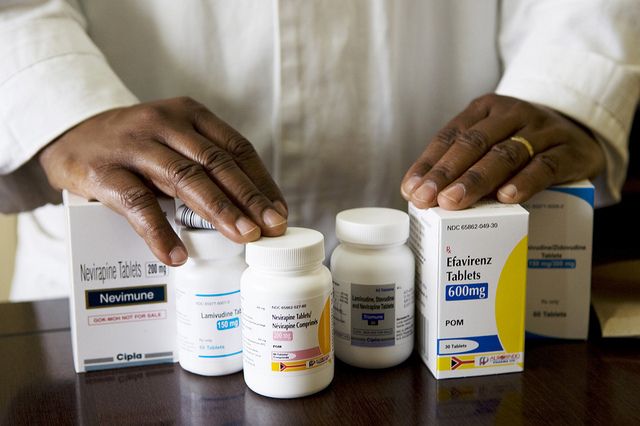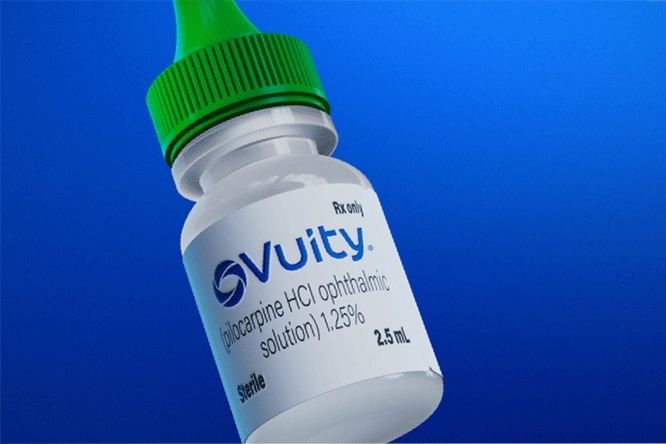
RONGAI KENYA, The clinical officer at Ray Drop-In Centre demonstrates the range of anti-retrovirals they can provide to clinic clients. (c) Nell Freeman for the Alliance
Human Immunodeficiency Virus (HIV) infection, once a rapidly progressive and fatal disease, has been transformed into a manageable chronic condition thanks to the advent of potent antiretroviral therapy (ART). ART involves the use of a combination of drugs that target different stages of the HIV life cycle, effectively suppressing viral replication, preserving immune function, and significantly improving the quality of life and life expectancy of individuals living with HIV. The primary goal of ART is to achieve an undetectable viral load, which not only prevents disease progression but also eliminates the risk of sexual transmission (Undetectable = Untransmittable, U=U).
Understanding the HIV Life Cycle as Drug Targets
To appreciate how antiretroviral drugs work, it’s crucial to understand the HIV life cycle. HIV is a retrovirus that primarily targets CD4+ T-lymphocytes, crucial cells in the human immune system. The life cycle involves several key steps, each presenting a potential target for drug intervention:
- Binding and Fusion: HIV’s outer envelope protein (gp120) binds to CD4 receptors and co-receptors (CCR5 or CXCR4) on the host cell surface. This binding triggers conformational changes, leading to the fusion of the viral and host cell membranes, allowing the viral core to enter the cell.
- Reverse Transcription: Once inside, the viral enzyme reverse transcriptase converts the single-stranded viral RNA into double-stranded viral DNA.
- Integration: The viral DNA is then transported into the cell nucleus, where another viral enzyme, integrase, splices the viral DNA into the host cell’s DNA. This integrated viral DNA is called a provirus.
- Replication: The host cell’s machinery is hijacked to transcribe the proviral DNA into new viral RNA, which serves as both genetic material for new virions and messenger RNA for viral protein synthesis.
- Assembly and Budding: Viral proteins and RNA assemble near the cell membrane, and newly formed immature virions bud off from the host cell.
- Maturation: Finally, the viral enzyme protease cleaves long chains of viral proteins into smaller, functional proteins, allowing the new virions to become infectious.
Antiretroviral drugs are categorized based on the specific step of this life cycle they inhibit.
Classes of Antiretroviral Drugs
1. Nucleoside/Nucleotide Reverse Transcriptase Inhibitors (NRTIs/NtRTIs)
Mechanism of Action: NRTIs and NtRTIs are pro-drugs that mimic the natural nucleosides (building blocks of DNA) used by the reverse transcriptase enzyme. Once phosphorylated into their active triphosphate forms within the host cell, they compete with natural nucleosides for incorporation into the growing viral DNA chain. When an NRTI/NtRTI is incorporated, it lacks a 3′-hydroxyl group, which is essential for the addition of further nucleotides. This causes premature termination of the DNA chain, effectively blocking the conversion of viral RNA into DNA and halting viral replication.
Common Drugs:
- Nucleoside RTIs (NRTIs): Emtricitabine (FTC), Lamivudine (3TC), Abacavir (ABC), Zidovudine (AZT), Stavudine (d4T), Didanosine (ddI).
- Nucleotide RTIs (NtRTIs): Tenofovir Disoproxil Fumarate (TDF), Tenofovir Alafenamide (TAF).
Side Effects: Historically, NRTIs were associated with significant mitochondrial toxicity, leading to lactic acidosis, hepatomegaly with steatosis, and peripheral neuropathy. While newer NRTIs have a better safety profile, potential side effects include:
- Gastrointestinal: Nausea, vomiting, diarrhea (common, often transient).
- Renal: TDF can cause renal tubular dysfunction, affecting bone mineral density. TAF, a pro-drug of tenofovir, achieves higher intracellular concentrations with lower plasma levels, leading to improved renal and bone safety compared to TDF.
- Hypersensitivity: Abacavir requires genetic screening for the HLA-B*5701 allele due to a risk of severe, potentially fatal hypersensitivity reactions.
- Hematological: Zidovudine can cause myelosuppression (anemia, neutropenia).
- Lipodystrophy: Particularly with older NRTIs like Stavudine and Zidovudine, characterized by fat wasting or accumulation.
2. Non-Nucleoside Reverse Transcriptase Inhibitors (NNRTIs)
Mechanism of Action: Unlike NRTIs, NNRTIs do not compete with nucleosides or require intracellular phosphorylation. Instead, they bind directly to a specific allosteric site on the reverse transcriptase enzyme, distinct from the active site. This binding induces a conformational change in the enzyme, disrupting its catalytic activity and preventing it from synthesizing viral DNA.
Common Drugs: Efavirenz (EFV), Rilpivirine (RPV), Doravirine (DOR), Nevirapine (NVP), Etravirine (ETR).
Side Effects:
- Central Nervous System (CNS): Efavirenz is notorious for CNS side effects, including dizziness, abnormal dreams, insomnia, confusion, and depression, which often occur within the first few weeks of treatment and may subside.
- Rash: All NNRTIs can cause rash, ranging from mild to severe (e.g., Stevens-Johnson Syndrome), particularly Nevirapine, which often requires a dose-escalation strategy.
- Hepatotoxicity: Nevirapine and Etravirine can cause liver enzyme elevations.
- Drug-Drug Interactions: NNRTIs are metabolized by and can induce or inhibit cytochrome P450 enzymes, leading to significant drug interactions.
3. Protease Inhibitors (PIs)
Mechanism of Action: Protease is a crucial viral enzyme that cleaves newly synthesized, long-chain viral polyproteins (Gag-Pol polyprotein) into smaller, functional proteins required for the assembly of mature, infectious virions. PIs mimic the peptide cleavage site of the polyprotein, binding to the active site of the protease enzyme and competitively inhibiting its activity. This results in the production of immature, non-infectious viral particles.
Common Drugs: Darunavir (DRV), Atazanavir (ATV), Lopinavir/ritonavir (LPV/r), Tipranavir (TPV). PIs are almost always “boosted” with low doses of Ritonavir (RTV) or Cobicistat (COBI) – potent CYP3A4 inhibitors – to increase their plasma concentrations and prolong their half-life, thereby enhancing their efficacy and allowing for less frequent dosing.
Side Effects:
- Metabolic Complications: PIs are associated with a range of metabolic issues, including dyslipidemia (elevated triglycerides and LDL cholesterol), insulin resistance, and lipodystrophy (changes in body fat distribution).
- Gastrointestinal: Nausea, vomiting, diarrhea (common).
- Hepatotoxicity: Can cause elevated liver enzymes.
- Hyperbilirubinemia: Atazanavir can cause unconjugated hyperbilirubinemia, leading to jaundice or scleral icterus (yellowing of skin/eyes), which is usually benign but cosmetically concerning.
- Drug-Drug Interactions: Significant interactions due to CYP3A4 inhibition by the PIs themselves and the boosting agents (Ritonavir/Cobicistat).
4. Integrase Strand Transfer Inhibitors (INSTIs)
Mechanism of Action: Integrase is another essential viral enzyme that facilitates the integration of viral DNA into the host cell’s genome. INSTIs bind to the integrase enzyme, preventing it from catalyzing the strand transfer step of integration. This blocks the provirus formation, effectively halting the viral life cycle at an early stage.
Common Drugs: Dolutegravir (DTG), Raltegravir (RAL), Elvitegravir (EVG – always co-formulated with Cobicistat), Bictegravir (BIC).
Side Effects: INSTIs are generally well-tolerated and are often preferred components in initial ART regimens due to their high efficacy and favorable side effect profile.
- General: Headache, insomnia, dizziness, nausea.
- Weight Gain: Recent studies have shown a link between INSTI use (particularly Dolutegravir and Bictegravir) and weight gain, which can be clinically significant for some patients.
- Renal: Cobicistat, used to boost Elvitegravir, can inhibit tubular secretion of creatinine, leading to a mild, reversible increase in serum creatinine that does not reflect true kidney damage.
- Neuropsychiatric: Rare reports of depression or anxiety, particularly in individuals with pre-existing conditions.
5. Fusion Inhibitors
Mechanism of Action: Fusion inhibitors act at the very first stage of the HIV life cycle – entry into the host cell. Enfuvirtide (T-20) is a synthetic 36-amino acid peptide that mimics a portion of the gp41 transmembrane glycoprotein. It binds to gp41, preventing the conformational change necessary for the fusion of the viral and host cell membranes, thus blocking viral entry.
Common Drugs: Enfuvirtide (T-20).
Side Effects:
- Injection Site Reactions: As Enfuvirtide is administered via subcutaneous injection, local reactions (pain, erythema, induration, nodules) are very common.
- Hypersensitivity: Rare but serious hypersensitivity reactions have been reported.
- Increased Risk of Bacterial Pneumonia: A slight increase in the risk of bacterial pneumonia has been observed. Fusion inhibitors are typically reserved for heavily treatment-experienced patients with multidrug-resistant HIV due to their injectable route of administration and complex usage.
6. CCR5 Antagonists
Mechanism of Action: CCR5 antagonists also block viral entry. Maraviroc (MVC) specifically binds to the CCR5 co-receptor on the surface of CD4+ T-cells. By blocking this co-receptor, Maraviroc prevents HIV (specifically R5-tropic strains, which utilize the CCR5 co-receptor) from binding to and entering the host cell. It is ineffective against X4-tropic or dual/mixed-tropic HIV strains.
Common Drugs: Maraviroc (MVC).
Side Effects:
- Hepatotoxicity: Rare but potentially severe hepatotoxicity.
- Orthostatic Hypotension: Due to its mechanism of action, it can cause dizziness when standing up.
- Rash: Skin rashes.
- Drug-Drug Interactions: Metabolized by CYP3A4, leading to potential interactions. Prior to initiating Maraviroc, tropism testing is mandatory to confirm the presence of R5-tropic virus.
7. Attachment Inhibitors
Mechanism of Action: These are a newer class of drugs. Fostemsavir (FTV) is a pro-drug that, once converted to temsavir, binds directly to the gp120 glycoprotein on the surface of the HIV virus. This binding blocks the initial attachment of the virus to the CD4 receptor on the host cell, preventing viral entry.
Common Drugs: Fostemsavir (FTV).
Side Effects:
- Gastrointestinal: Nausea, diarrhea (common).
- Liver Enzyme Elevations.
- QTc prolongation: Can prolong the QT interval on an ECG. Fostemsavir is indicated for heavily treatment-experienced adults with multi-drug resistant HIV infection who have limited treatment options.
8. Post-Attachment Inhibitors
Mechanism of Action: Ibalizumab (IBA) is a monoclonal antibody that binds to the CD4 receptor on host T-cells, but at an epitope distinct from the HIV binding site. It induces conformational changes in the CD4 receptor, preventing the post-attachment steps required for the virus to enter the cell. Unlike other entry inhibitors, it does not suppress normal immune function.
Common Drugs: Ibalizumab (IBA).
Side Effects:
- Infusion-related reactions: Due to its intravenous administration.
- Gastrointestinal: Nausea, diarrhea.
- Rash, dizziness. Ibalizumab is also reserved for heavily treatment-experienced patients with multidrug-resistant HIV, administered via intravenous infusion.
Combination Antiretroviral Therapy (ART)
Modern HIV treatment relies on combination ART, typically involving a regimen of three or more active drugs from at least two different drug classes. This strategy is crucial for several reasons:
- Maximal Viral Suppression: Targeting multiple steps in the viral life cycle simultaneously ensures comprehensive inhibition of replication.
- Prevention of Drug Resistance: HIV has a high mutation rate. Using multiple drugs makes it much harder for the virus to develop resistance to all drugs in the regimen concurrently.
- Improved Efficacy and Durability: Combination therapy provides sustained viral suppression and preserves immune function more effectively than monotherapy.
Current guidelines recommend initial ART regimens typically include two NRTIs as a backbone, combined with a third active drug, which is usually an INSTI, occasionally an NNRTI, or a boosted PI. The development of single-pill, fixed-dose combination regimens has significantly improved adherence and simplified treatment for many individuals.
Adherence and Monitoring
Optimal adherence to ART is paramount for treatment success. Missing doses allows viral replication to rebound, increasing the risk of drug resistance and treatment failure. Regular monitoring of viral load (HIV RNA levels), CD4+ T-cell counts, and routine laboratory parameters is essential to assess treatment efficacy, detect potential side effects, and guide any necessary adjustments to the regimen.
Conclusion
The evolution of antiviral drugs for HIV has been a remarkable scientific achievement, transforming a dreaded disease into a manageable chronic condition. From early nucleoside analogues to modern integrase inhibitors and novel entry inhibitors, each class of drugs offers unique mechanisms to disrupt the HIV life cycle. While these medications come with various side effects, ongoing research continues to refine existing therapies and develop new compounds with improved efficacy, safety, and convenience. The comprehensive understanding and judicious application of these antiviral agents remain central to the ongoing fight against HIV, offering hope and extending healthy lives for millions worldwide.
References
- Department of Health and Human Services. (2023). Guidelines for the Use of Antiretroviral Agents in Adults and Adolescents with HIV. National Institutes of Health. Retrieved from https://clinicalinfo.hiv.gov/en/guidelines/adult-and-adolescent-arv/whats-new-guidelines
- World Health Organization. (2021). Consolidated Guidelines on HIV Prevention, Testing, Treatment, Service Delivery and Monitoring: 2021. WHO Press. Retrieved from https://www.who.int/publications/i/item/9789240031593
- Croxtall, J. D., & Perry, C. M. (2012). Rilpivirine: in HIV-1 infection. Drugs, 72(13), 1735-1746.
- Flexner, C. (2007). HIV-1 protease inhibitors. The Journal of Clinical Pharmacology, 47(12), 1546-1552.
- De Clercq, E. (2007). Antiviral drugs: current state of the art. Journal of Clinical Virology, 39(3), 161-169.
- Wensing, A. M., van de Vijver, D. A., & Angarano, G. (2017). HIV drug resistance in Europe: a systematic review. HIV Medicine, 18(s1), 1-8.
- Sax, P. E., Pozniak, A. L., & Rachlis, A. (2012). Tenofovir alafenamide versus tenofovir disoproxil fumarate for the treatment of HIV-1 infection. JAIDS Journal of Acquired Immune Deficiency Syndromes, 60(5), 450-456.
- Ciccarelli, N., et al. (2020). Weight Gain in People Living with HIV Initiating Integrase Inhibitor-Based Antiretroviral Therapy. Journal of Acquired Immune Deficiency Syndromes, 83(5), 457-466.
- Riddler, S. A., et al. (2003). Class-Sparing Antiretroviral Regimen for Initial Treatment of HIV-1 Infection. New England Journal of Medicine, 348(22), 2201-2210.
- Lalezari, J. P., et al. (2003). Enfuvirtide, an HIV-1 fusion inhibitor, in advanced antiretroviral treatment-experienced patients. New England Journal of Medicine, 348(22), 2175-2185.
- Markowitz, M., et al. (2007). Maraviroc plus optimized background therapy in treatment-experienced patients with R5 HIV-1 infection. New England Journal of Medicine, 356(13), 1315-1326.
- Gonsalves, A. R., et al. (2021). Fostemsavir: Clinical efficacy, safety, and place in therapy. AIDS Reviews, 23(1), 11-20.
- Emu, B., et al. (2018). Ibalizumab in patients with multidrug-resistant HIV-1 infection. New England Journal of Medicine, 379(7), 645-654.







